Preface
Why are you reading the preface? The book really gets going in about 10 pages, so why are you here instead of there? Are you the kind of person who can’t stand the idea of missing something? Are you trying to justify the cost of the book by consuming every word? Did you just open to this page out of habit? Are you starting to think that maybe you made a big mistake?
For as long as we can remember, we’ve been asking questions like these about ourselves, about our friends, and about anyone else who didn’t run away fast enough. Our curiosity about why people think, feel, and act as they do drew each of us into our first psychology course, and though we remember being swept away by the lectures, we don’t remember much about our textbooks. That’s probably because those textbooks were little more than colorful encyclopedias of facts, names, and dates. Little wonder that we sold them back to the bookstore the moment we finished our final exams.
When we became psychology professors, we did the things that psychology professors often do: We taught classes, we conducted research, and we wore sweater vests long after they stopped being fashionable. We also wrote stuff that people truly enjoyed reading, and that made us wonder why no one had ever written an introductory psychology textbook that students truly enjoyed reading. After all, psychology is the single most interesting subject in the known universe, so why shouldn’t a psychology textbook be the single most interesting object in a student’s backpack? We couldn’t think of a reason, so we sat down and wrote the book that we wished we’d been given as students. Psychology was published in 2008, and the reaction to it was nothing short of astounding. We’d never written a textbook before, so we didn’t know exactly what to expect, but never in our wildest dreams did we imagine that we would win the Pulitzer Prize!

Which was good, because we didn’t. But what did happen was even better: We started getting letters and emails from students all over the country who just wanted to tell us how much they liked reading our book. They liked the content, of course, because as we may have already mentioned, psychology is the single most interesting subject in the known universe. But they also liked the fact that our textbook didn’t sound like a textbook. It wasn’t written in the stodgy voice of the announcer from one of those nature films that we all saw in seventh grade biology (“Behold the sea otter, nature’s furry little scavenger”). Rather, it was written in our voices—
The last edition of our book was a hit—
xx
Changes in the Third Edition
New focus on critical thinking
As sciences uncover new evidence and develop new theories, scientists change their minds. Some of the facts that students learn in a science course will still be facts a decade later, and others will require qualification or will turn out to have just been plain wrong. That’s why students not only need to learn the facts but also how to think about facts—
New section “Learning in the Classroom”
Like other psychology textbooks, the first two editions of our text provided in-
New research
A textbook should give students a complete tour of the classics, of course, but it should also take them out dancing on the cutting edge. We want students to realize that psychology is not a museum piece—
xxi
| Chapter Number | Hot Science |
|---|---|
| 1 | Psychology as a Hub Science, p. 34 |
| 2 | Do Violent Movies Make Peaceful Streets?, p. 64 |
| 3 | Epigenetics and the Persisting Effects of Early Experiences, p. 112 |
| 4 | Taste: From the Top Down, p. 169 |
| 5 | The Mind Wanders, p. 185 |
| 6 | Sleep on It, p. 233 |
| 7 | Dopamine and Reward Learning in Parkinson’s Disease, p. 292 |
| 8 | The Body of Evidence, p. 325 |
| 9 | Sudden Insight and the Brain, p. 386 |
| 10 | Dumb and Dumber?, p. 414 |
| 11 | A Statistician in the Crib, p. 435 |
| 11 | The End of History Illusion, p. 460 |
| 12 | Personality on the Surface, p. 479 |
| 13 | Mouse Over, p. 516 |
| 13 | The Wedding Planner, p. 538 |
| 14 | Can Being the Target of Discrimination Cause Stress and Illness?, p. 552 |
| 15 | Optimal Outcome in Autism Spectrum Disorder, p. 615 |
| 16 | “Rebooting” Psychological Treatment, p. 642 |
Fully updated coverage of DSM-5
One area where there has been lots of new research—
New organization
We’ve also rearranged our table of contents to better fit our changing sense of how psychology is best taught. Specifically, we’ve moved the chapter on Stress and Health forward so that it now appears before the chapters on Psychological Disorders and Treatment of Psychological Disorders. We think this change improves the flow of the book in several ways. First, as you will learn, the experience of stress has a lot to do with interpersonal events and how we respond to them, information that you will have just learned about in the chapters on Personality and Social Psychology. Second, current models of psychological disorders view them as resulting from an interaction of some underlying predisposition (e.g., genetic or otherwise) and stressful life events. Such models will be much more intuitive if you first learn about the body’s stress response. Third, this chapter has information about health-
xxii
New Other Voices feature
Long before psychologists appeared on Earth, the human nature business was dominated by poets, playwrights, pundits, philosophers, and several other groups beginning with P. Those folks are still in that business today, and they continue to have deep and original insights into how and why people behave as they do. In this edition, we decided to invite some of them to share their thoughts with you via a new feature that we call “Other Voices.” In every chapter, you will find a short essay by someone who has three critical qualities: (a) They think deeply, (b) they write beautifully, and (c) they know things we don’t. For example, you will find essays by leading journalists such as David Brooks, Ted Gup, Tina Rosenberg, and David Ewing Duncan; best-
| Chapter Number | Other Voices |
|---|---|
| 1 | Is Psychology a Science?, p. 17 |
| 2 | Can We Afford Science?, p. 75 |
| 3 | Neuromyths, p. 124 |
| 4 | Hallucinations and the Visual System, p. 173 |
| 5 | A Judge’s Plea for Pot, p. 217 |
| 6 | Early Memories, p. 261 |
| 7 | Online Learning, p. 308 |
| 8 | Fat and Happy, p. 339 |
| 9 | Americans’ Future Has to Be Bilingual, p. 364 |
| 10 | How Science Can Build a Better You, p. 421 |
| 11 | Men, Who Needs Them?, p. 429 |
| 11 | You Are Going to Die, p. 467 |
| 12 | Does the Study of Personality Lack … Personality?, p. 503 |
| 13 | 91% of All Students Read This Box and Love It, p. 531 |
| 14 | Building a Healthier Society?, p. 579 |
| 15 | Successful and Schizophrenic, p. 613 |
| 16 | Diagnosis: Human, p. 653 |
New Changing Minds questions
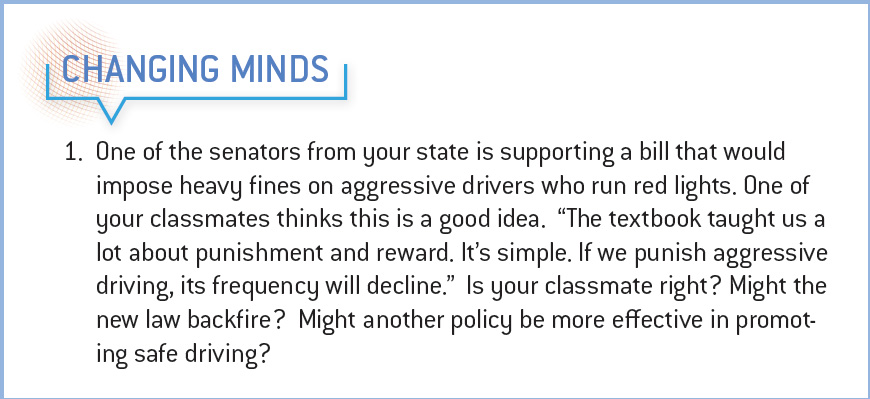
What can 784 introductory psychology professors agree about? They can agree that students usually come into their first psychology class with a set of beliefs about the field and that most of these beliefs are wrong. With the help of the wonderful people at Worth Publishers (they made us say that), we conducted a survey of 784 introductory psychology teachers and asked them to name their students’ most common misconceptions about psychology. We then created the Changing Minds questions you will see at the end of every chapter. These questions ask you first to think about an everyday situation in which a common misconception might arise, and then to use the science you have just learned to overcome that misconception. We hope these exercises will prepare you to apply what you learn—
Additional Student Support
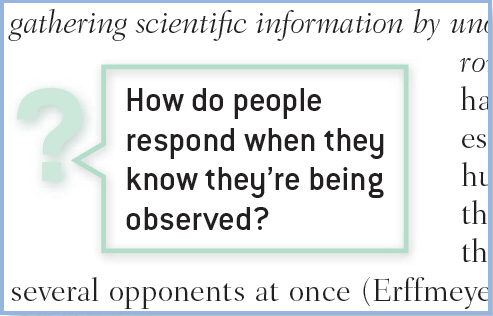
Practice
 Cue questions encourage critical thinking and help identify the most important concepts in every major section of the text.
Cue questions encourage critical thinking and help identify the most important concepts in every major section of the text. Bulleted summaries follow each major section to reinforce key concepts and make it easier to study for the test.
Bulleted summaries follow each major section to reinforce key concepts and make it easier to study for the test.
 A Key Concept Quiz at the end of each chapter offers students the opportunity to test what they know.
A Key Concept Quiz at the end of each chapter offers students the opportunity to test what they know. Critical thinking questions are offered throughout the chapters within a number of the photo captions, offering the opportunity to apply various concepts.
Critical thinking questions are offered throughout the chapters within a number of the photo captions, offering the opportunity to apply various concepts.
Practical Application

Critical thinking questions in a photo caption from Chapter 4.
What would the facts and concepts of psychology be without real-
| Chapter Number | The Real World |
|---|---|
| 1 | The Perils of Procrastination, p. 4 |
| 1 | Improving Study Skills, p. 10 |
| 2 | Oddsly Enough, p. 61 |
| 3 | Brain Plasticity and Sensations in Phantom Limbs, p. 104 |
| 3 | Brain Death and the Vegetative State, p. 123 |
| 4 | Multitasking, p. 135 |
| 4 | Music Training: Worth the Time, p. 162 |
| 5 | Drugs and the Regulation of Consciousness, p. 212 |
| 6 | Is Google Hurting Our Memories?, p. 248 |
| 7 | Understanding Drug Overdoses, p. 270 |
| 8 | Jeet Jet?, p. 337 |
| 9 | From Zippers to Political Extremism: An Illusion of Understanding, p. 390 |
| 10 | Look Smart, p. 400 |
| 11 | Walk This Way, p. 442 |
| 12 | Are There “Male” and “Female” Personalities?, p. 481 |
| 13 | Making the Move, p. 519 |
| 14 | This is Your Brain on Placebos, p. 571 |
| 15 | How Are Mental Disorders Defined and Diagnosed?, p. 592 |
| 16 | Types of Psychotherapists, p. 630 |
| 16 | Treating Severe Mental Disorders, p. 647 |
| Chapter Number | Culture & Community |
|---|---|
| 1 | Analytic and Holistic Styles in Western and Eastern Cultures, p. 30 |
| 2 | Best Place to Fall on Your Face, p. 45 |
| 4 | Does Culture Influence Change Blindness?, p. 156 |
| 5 | What Do Dreams Mean to Us around the World?, p. 201 |
| 6 | Does Culture Affect Childhood Amnesia?, p. 240 |
| 7 | Are There Cultural Differences in Reinforcers?, p. 281 |
| 8 | Is It What You Say or How You Say It?, p. 329 |
| 9 | Does Culture Influence Optimism Bias?, p. 378 |
| 12 | Does Your Personality Change According to the Language You’re Speaking?, p. 492 |
| 13 | Free Parking, p. 528 |
| 14 | Land of the Free, Home of the … Stressed?, p. 566 |
| 15 | What Do Mental Disorders Look Like in Different Parts of the World?, p. 589 |
| 16 | Treatment of Psychological Disorders around the World, p. 632 |
xxiv
Culture and Multicultural Experience
Aggression and culture, p. 511
and geography, p. 511
groups, p. 514
Aging population, pp. 460–467
Alcohol, binge drinking, p. 207
Attachment style, pp. 443–444
Attractiveness, p. 518
Autism, pp. 439, 614–615
Body ideal, p. 519
Brain death, p. 123
Conformity, p. 529
Culture, discovering, pp. 440–441
Cultural norms, pp. 528–529
Cultural psychology,
definition, pp. 28–30
Deaf culture, pp. 356, 439
Depression, pp. 601–604
Development
adolescence, protracted, pp. 453–455
attachment, p. 443
child-
cognitive development, pp. 433–435
counting ability, p. 440
moral development, p. 446
Dreams, meaning of, p. 201
Drugs, psychological effects of, pp. 646–654
Eating disorders, pp. 334–338
Expression, display rules, p. 326
Expression, universality, p. 323
False memories, pp. 255–256
Family therapy, p. 643
Freedom, p. 528
Helpfulness, p. 45
Homosexuality
genes, p. 456
pheromones, p. 170
views on, pp. 455–456
Hunger, pp. 333–334
Implicit learning, aging, p. 303
Intelligence, pp. 406–407, 417–421
age, pp. 410–412
cultural aspects, pp. 406–407
education on, pp. 414–415
generational, p. 413
socioeconomic factors and, pp. 399–400, 410, 413–415
testing bias, pp. 417–419
Intrinsic motivation, p. 442
Language
bilingualism, pp. 363–365
memory retrieval, p. 236
and personality, pp. 491–492
structure, pp. 353–355
and thought, pp. 367–368
Life expectancy, p. 465
Marijuana laws, pp. 211–213
Marriage, pp. 524–525
Mating preferences, pp. 518–524
Minorities in psychology, pp. 31–32
Movie violence, p. 64
Norms, pp. 528–529
Obesity, p. 577
Observational learning, pp. 295–297
Parent and peer relationships, pp. 458–459
Perceptual illusions, pp. 20–21
Prejudice and stereotyping, p. 28
Psychoanalysis, pp. 633–634
Psychological disorders
antisocial personality disorder, pp. 619–620
eating disorders, pp. 334–338
outlook on in different cultures, pp. 585, 589
schizophrenia, pp. 607–608
Psychotherapy, p. 630
Racism
civil rights, p. 28
stress, p. 553
Reasoning, p. 388
Research ethics, pp. 70–74
Sensory branding, p. 129
Stereotype threat, p. 541
Stereotyping, p. 538
Stress
adjusting to a new culture, p. 566
chronic, p. 552
poverty and inequality, p. 557
Subliminal perception, p. 191
Suicide, pp. 621–622
Taste preference, pp. 170–172
Teen pregnancy, p. 457
Threat reaction, p. 559
Tone of voice and meaning, p. 329
The Psychology of Men and Women
Aggression and biology, pp. 509–510
Alcohol
myopia, pp. 208–209
pregnancy, pp. 429–430
Attraction, p. 518
Beauty standards of, pp. 521–522
Biological sex/gender, pp. 453–457
Body image, p. 334
Child-
attachment and, pp. 443–446
day care, p. 446
Dating, pp. 517–518
Dieting, pp. 337–338
Eating disorders, pp. 334–338
Freud’s views, pp. 13–14, 487-
Gender and social connectedness, p. 465
Happiness, p. 463
Hormones, p. 453
Hostility and heart disease, p. 558
Jealously, p. 26
Life expectancy, p. 464
Life satisfaction, p. 463
Marriage, pp. 465–466
Mating preferences
biological, pp. 517–518
cultural, pp. 517–518
xxv
Menarche, p. 453
Moral development, pp. 446–451
Personality, pp. 479, 481
Pheromones, pp. 170
Physical development, pp. 450–454
Pregnancy
health of mother and child, pp. 428–430
teen, p. 457
Psychological disorders, depression, p. 602
panic disorder, p. 596
Rape, pp. 208–209
Relationships, p. 524
Sex
avoiding risks, p. 340
motivation for, pp. 338–340
and teens, pp. 338–340
Social connectedness, pp. 566–568
Stereotyping, p. 538
Stress, coping, pp. 561–563
Suicide, pp. 621–622
Talkativeness, p. 476
Women in psychology, pp. 31–32

xxvi
Focus on Learning Outcomes
Teaching with the APA Learning Goals and Outcomes
In an effort to develop greater consensus on goals and learning outcomes for undergraduate education in psychology, the American Psychological Association (APA) created a task force on Undergraduate Psychology Major Competencies to provide a framework for educators. The task force subsequently published comprehensive recommendations in The APA Guidelines for the Undergraduate Psychology Major, recently revised for version 2.0 that was released in May 2013. These revised guidelines present a rigorous standard for what students should gain from foundational courses and from the psychology major as a whole. They comprise five goals relating to the following:
- Goal 1: Knowledge Base in Psychology
- Goal 2: Scientific Inquiry and Critical Thinking
- Goal 3: Ethical and Social Responsibility in a Diverse World
- Goal 4: Communication
- Goal 5: Professional Development
The intent of the APA Task Force is to provide overarching goals without dictating exactly how students and teachers should achieve them. In that spirit, Worth Publishers offers a wide variety of resources to support students and teachers in achieving the APA outcomes. Most important, a concordance of the content in Psychology, Third Edition, to the APA goals is available for download from the Resources area of LaunchPad at http:/
Preparing for the MCAT 2015
From 1977 to 2014, the Medical College Admission Test (MCAT) focused on biology, chemistry, and physics, but starting with the test to be administered in 2015, 25% of its questions will cover “Psychological, Social, and Biological Foundations of Behavior,” with most of those questions concerning the psychological science taught in introductory psychology courses. According to the Preview Guide for the MCAT 2015 Exam, Second Edition, the addition of this content “recognizes the importance of socio-
xxvii
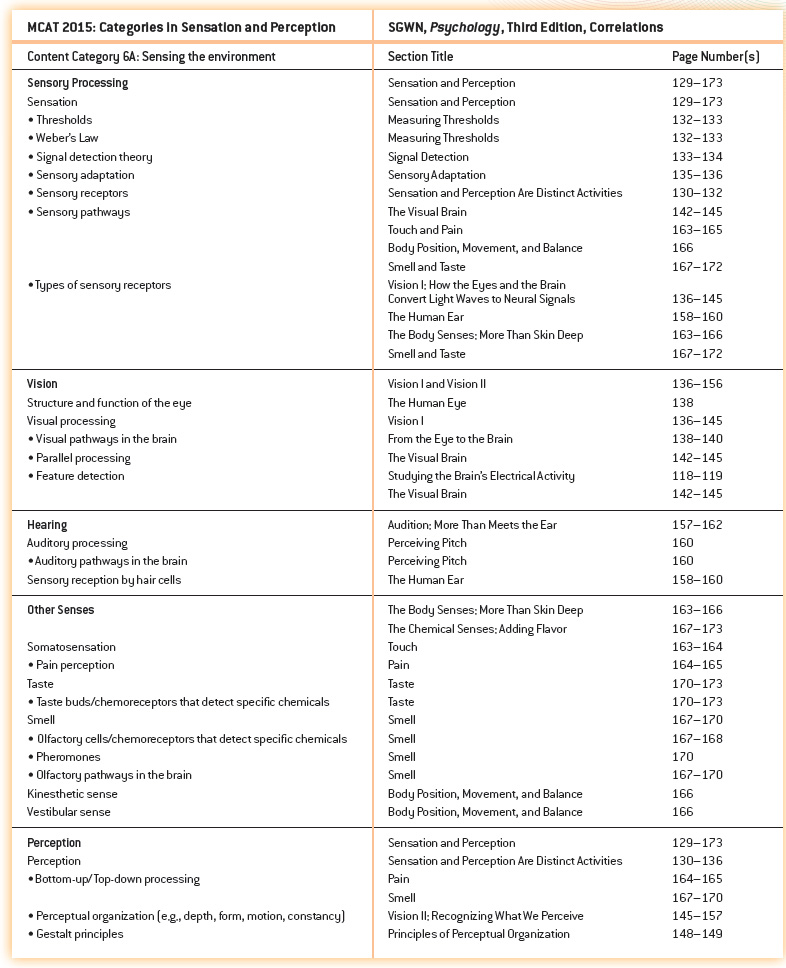
xxviii
Media and Supplements
LaunchPad with LearningCurve Quizzing
A comprehensive web resource for teaching and learning psychology
LaunchPad combines Worth Publishers’ award-
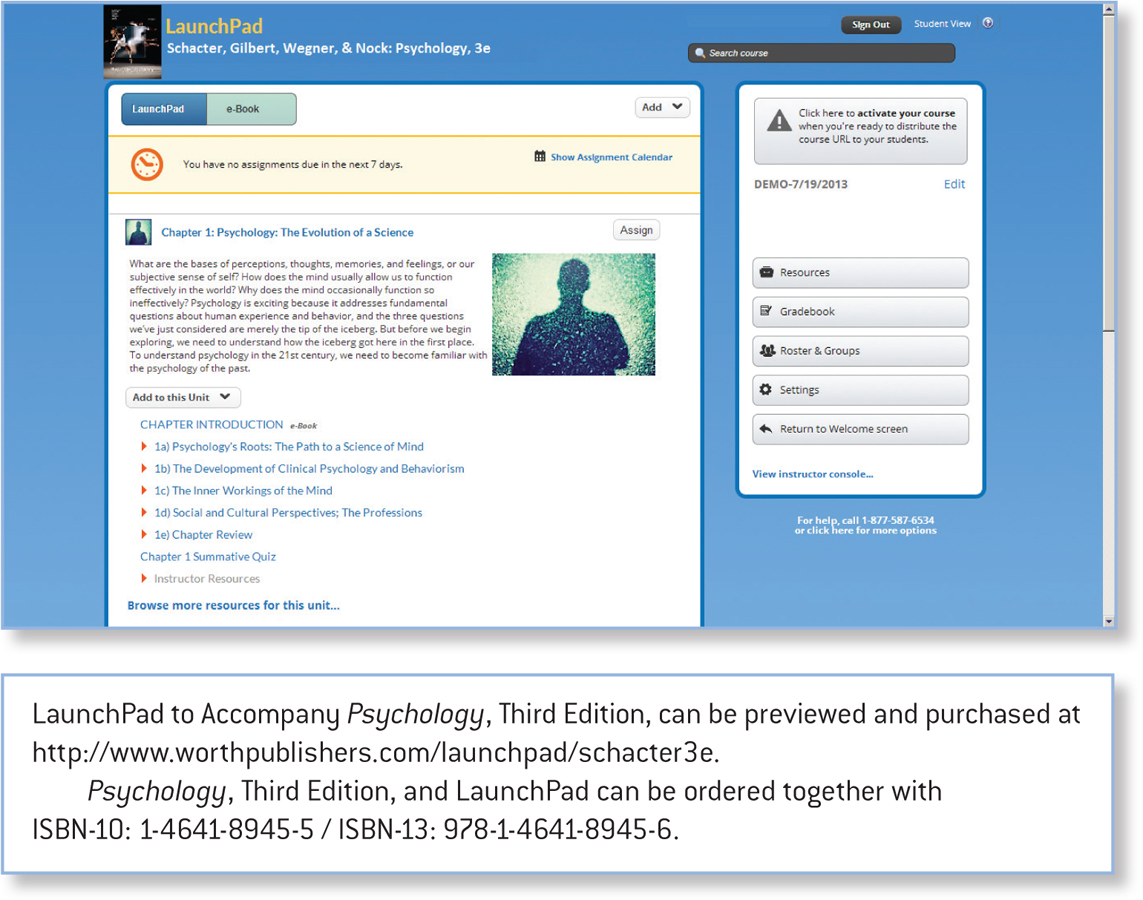
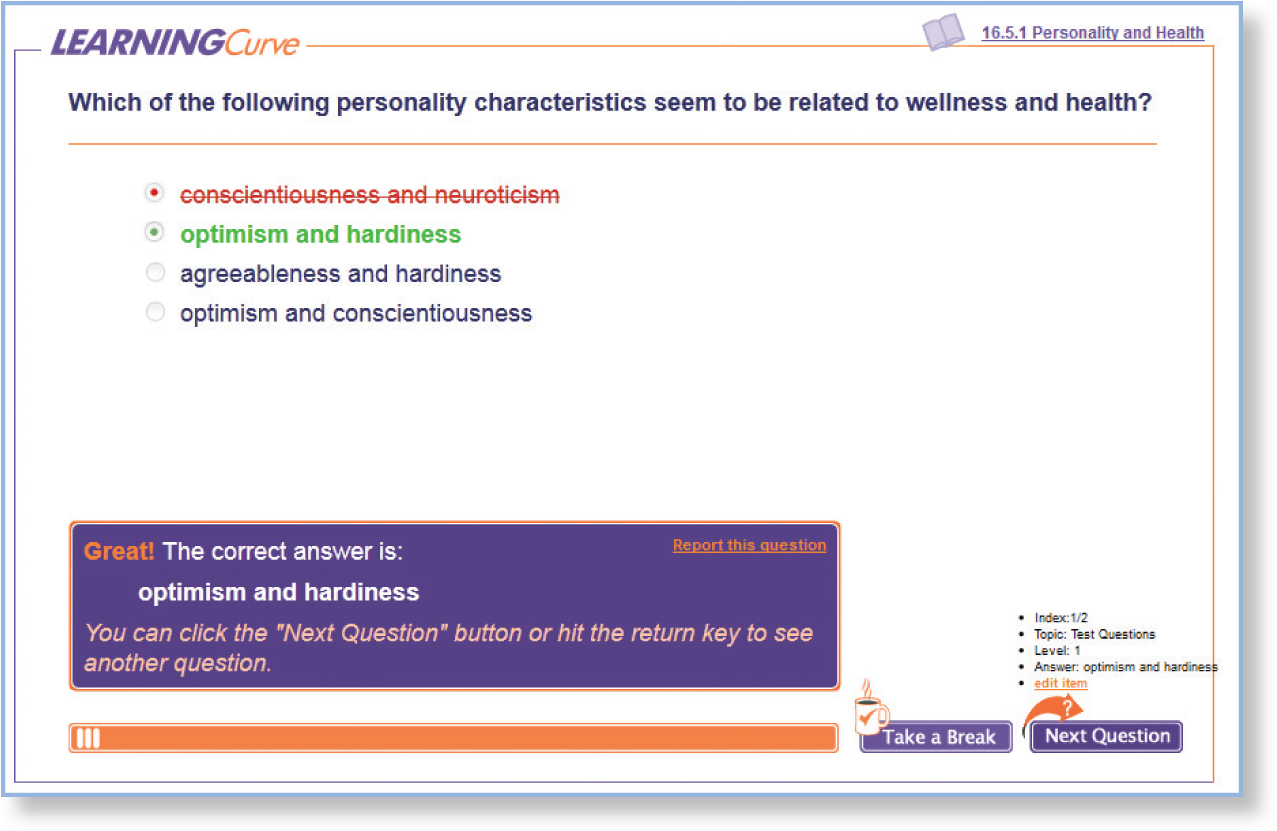
LaunchPad for Psychology, Third Edition, includes all the following resources:
 The design of the LearningCurve quizzing system is based on the latest findings from learning and memory research. It combines adaptive question selection, immediate and valuable feedback, and a gamelike interface to engage students in a learning experience that is unique to them. Each LearningCurve quiz is fully integrated with other resources in LaunchPad through the Personalized Study Plan, so students will be able to review using Worth’s extensive library of videos and activities. And state-
The design of the LearningCurve quizzing system is based on the latest findings from learning and memory research. It combines adaptive question selection, immediate and valuable feedback, and a gamelike interface to engage students in a learning experience that is unique to them. Each LearningCurve quiz is fully integrated with other resources in LaunchPad through the Personalized Study Plan, so students will be able to review using Worth’s extensive library of videos and activities. And state-of- the- art question analysis reports allow instructors to track the progress of individual students as well as their class as a whole.  New! Data Visualization Exercises offer students practice in understanding and reasoning about data. In each activity, students interact with a graph or visual display of data and must think like a scientist to answer the accompanying questions. These activities build quantitative reasoning skills and offer a deeper understanding of how science works.
New! Data Visualization Exercises offer students practice in understanding and reasoning about data. In each activity, students interact with a graph or visual display of data and must think like a scientist to answer the accompanying questions. These activities build quantitative reasoning skills and offer a deeper understanding of how science works. An interactive e-
An interactive e-Book allows students to highlight, bookmark, and scribble in their own notes on the e-Book page, just as they would with a printed textbook. Google- style searching and in- text glossary definitions make the text ready for the digital age.  Student Video Activities include more than 100 engaging video modules that instructors can easily assign and customize for student assessment. Videos cover classic experiments, current news footage, and cutting-
Student Video Activities include more than 100 engaging video modules that instructors can easily assign and customize for student assessment. Videos cover classic experiments, current news footage, and cutting-edge research, all of which are sure to spark discussion and encourage critical thinking.  Psychlnvestigator: Laboratory Learning in Introductory Psychology is a series of activities that model a virtual laboratory and are produced in association with Arthur Kohn, Ph.D, of Dark Blue Morning Productions. Students are introduced to core psychological concepts by a video host and then participate in activities that generate real data and lead to some startling conclusions! Like all activities in LaunchPad, PsychInvestigator activities can be assigned and automatically graded.
Psychlnvestigator: Laboratory Learning in Introductory Psychology is a series of activities that model a virtual laboratory and are produced in association with Arthur Kohn, Ph.D, of Dark Blue Morning Productions. Students are introduced to core psychological concepts by a video host and then participate in activities that generate real data and lead to some startling conclusions! Like all activities in LaunchPad, PsychInvestigator activities can be assigned and automatically graded. The award-
The award-winning tutorials in Tom Ludwig’s (Hope College) PsychSim 5.0 and Concepts in Action provide an interactive, step- by- step introduction to key psychological concepts.  The Scientific American Newsfeed delivers weekly articles, podcasts, and news briefs on the very latest developments in psychology from the first name in popular science journalism.
The Scientific American Newsfeed delivers weekly articles, podcasts, and news briefs on the very latest developments in psychology from the first name in popular science journalism.
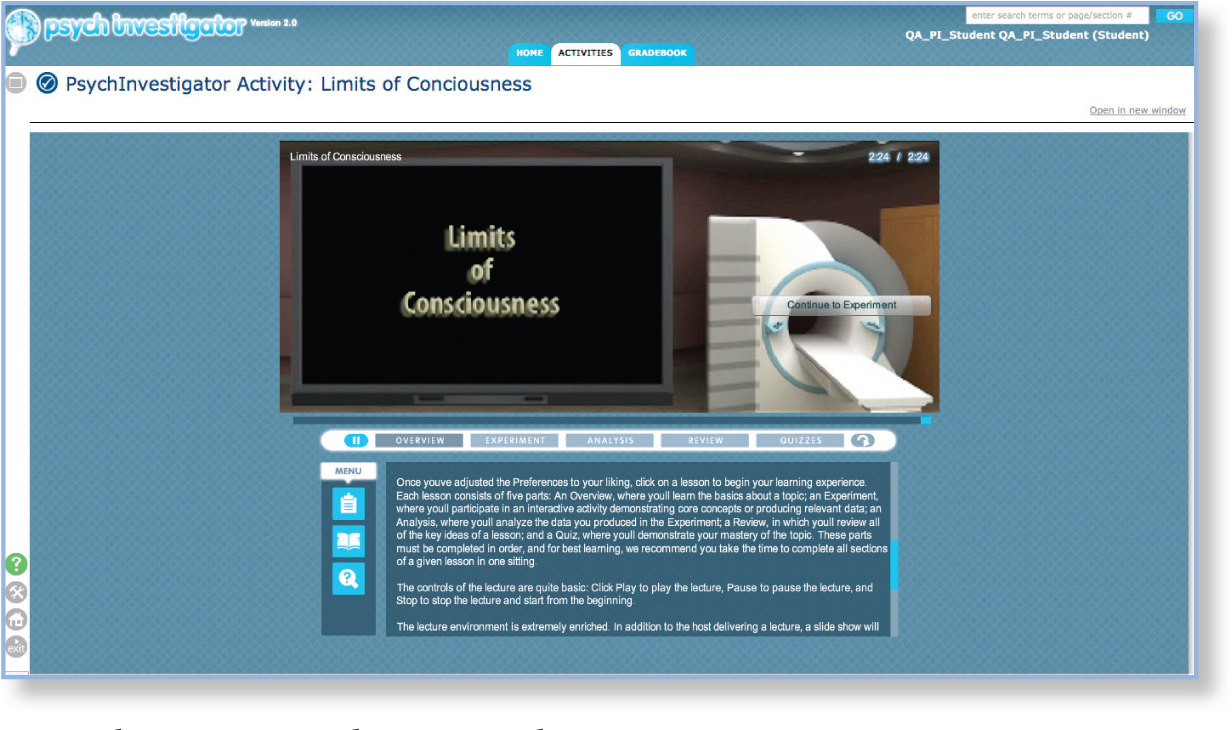
Additional Student Supplements
 The CourseSmart e-
The CourseSmart e-Book offers the complete text of Psychology, Third Edition, in an easy-to- use format. Students can choose either to purchase the CourseSmart e- Book as an online subscription or to download it to a personal computer or a portable media player, such as a smart phone or iPad. The CourseSmart e- Book for Psychology, Third Edition, can be previewed and purchased at www.coursesmart.com.  Pursuing Human Strengths: A Positive Psychology Guide by Martin Bolt of Calvin College is a perfect way to introduce students to both the amazing field of positive psychology as well as their own personal strengths.
Pursuing Human Strengths: A Positive Psychology Guide by Martin Bolt of Calvin College is a perfect way to introduce students to both the amazing field of positive psychology as well as their own personal strengths.Take advantage of our most popular supplements!
Worth Publishers is pleased to offer cost-
saving packages of Psychology, Third Edition, with our most popular supplements. Below is a list of some of the most popular combinations available for order through your local bookstore. Psychology, 3rd Ed. & LaunchPad Access Card
ISBN-
10: 1- 4641- 8945- 5/ISBN- 13: 978- 1- 4641- 8945- 6 Psychology, 3rd Ed. & iClicker 2
ISBN-
10: 1- 4641- 8990- 0/ISBN- 13: 978- 1- 4641- 8990- 6 Psychology, 3rd Ed. & Scientific American Reader
ISBN-
10: 1- 4641- 8946- 3/ISBN- 13: 978- 1- 4641- 8946- 3 Psychology, 3rd Ed. & Psychology and the Real World
ISBN-
10: 1- 4641- 8944- 7/ISBN- 13: 978- 1- 4641- 8944- 9  The Critical Thinking Companion for Introductory Psychology, by Jane S. Halonen of the University of West Florida and Cynthia Gray of Beloit College, contains both a guide to critical thinking strategies as well as exercises in pattern recognition, practical problem solving, creative problem solving, scientific problem solving, psychological reasoning, and perspective-
The Critical Thinking Companion for Introductory Psychology, by Jane S. Halonen of the University of West Florida and Cynthia Gray of Beloit College, contains both a guide to critical thinking strategies as well as exercises in pattern recognition, practical problem solving, creative problem solving, scientific problem solving, psychological reasoning, and perspective-taking.  Worth Publishers is proud to offer several readers of articles taken from the pages of Scientific American. Drawing on award-
Worth Publishers is proud to offer several readers of articles taken from the pages of Scientific American. Drawing on award-winning science journalism, the Scientific American Reader to Accompany Psychology, Third Edition, by Daniel L. Schacter, Daniel T. Gilbert, Daniel M. Wegner, and Matthew K. Nock features pioneering and cutting- edge research across the fields of psychology. Selected by the authors themselves, this collection provides further insight into the fields of psychology through articles written for a popular audience.  Psychology and the Real World: Essays Illustrating Fundamental Contributions to Society is a superb collection of essays by major researchers that describe their landmark studies. Published in association with the not-
Psychology and the Real World: Essays Illustrating Fundamental Contributions to Society is a superb collection of essays by major researchers that describe their landmark studies. Published in association with the not-forprofit FABBS Foundation, this engaging reader includes Elizabeth Loftus’s own reflections on her study of false memories, Eliot Aronson on his cooperative classroom study, and Daniel Wegner on his study of thought suppression. A portion of all proceeds is donated to FABBS to support societies of cognitive, psychological, behavioral, and brain sciences.
Course Management
 Worth Publishers supports multiple Course Management Systems with enhanced cartridges for upload into Blackboard, eCollege, Angel, Desire2Learn, Sakai, and Moodle. Cartridges are provided free upon adoption of Psychology, Third Edition, and can be downloaded from Worth’s online catalog at www.worthpublishers.com.
Worth Publishers supports multiple Course Management Systems with enhanced cartridges for upload into Blackboard, eCollege, Angel, Desire2Learn, Sakai, and Moodle. Cartridges are provided free upon adoption of Psychology, Third Edition, and can be downloaded from Worth’s online catalog at www.worthpublishers.com.
Assessment
 The Computerized Test Bank powered by Diploma includes a full assortment of test items from author Chad Galuska of the College of Charleston. Each chapter features over 200 multiple-
The Computerized Test Bank powered by Diploma includes a full assortment of test items from author Chad Galuska of the College of Charleston. Each chapter features over 200 multiple-choice, true/false, and essay questions to test students at several levels of Bloom’s taxonomy. The new edition also features a new set of data- based reasoning questions to test advanced critical thinking skills in a manner similar to the MCAT. All the questions are matched to the outcomes recommended in the 2013 APA Guidelines for the Undergraduate Psychology Major. The accompanying grade book software makes it easy to record students’ grades throughout a course, to sort student records, to view detailed analyses of test items, to curve tests, to generate reports, and to add weights to grades.  The iClicker Classroom Response System is a versatile polling system developed by educators for educators that makes class time more efficient and interactive. iClicker allows you to ask questions and instantly record your students’ responses, take attendance, and gauge students’ understanding and opinions. iClicker is available at a 10% discount when packaged with Psychology, Third Edition.
The iClicker Classroom Response System is a versatile polling system developed by educators for educators that makes class time more efficient and interactive. iClicker allows you to ask questions and instantly record your students’ responses, take attendance, and gauge students’ understanding and opinions. iClicker is available at a 10% discount when packaged with Psychology, Third Edition.
Presentation
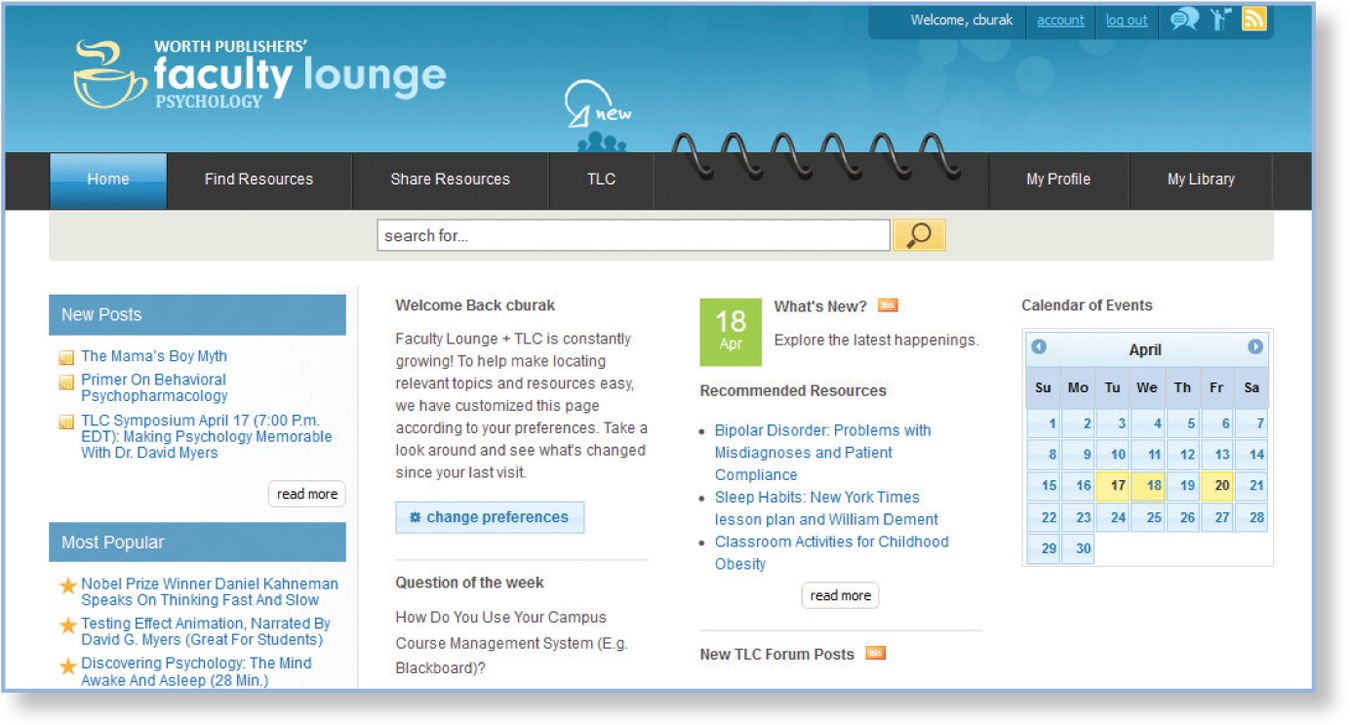

 Interactive Presentation Slides are another great way to introduce Worth’s dynamic media into the classroom without lots of advance preparation. Each presentation covers a major topic in psychology and integrates Worth’s high quality videos and animations for an engaging teaching and learning experience. These interactive presentations are complimentary to adopters of Psychology, Third Edition, and are perfect for technology novices and experts alike.
Interactive Presentation Slides are another great way to introduce Worth’s dynamic media into the classroom without lots of advance preparation. Each presentation covers a major topic in psychology and integrates Worth’s high quality videos and animations for an engaging teaching and learning experience. These interactive presentations are complimentary to adopters of Psychology, Third Edition, and are perfect for technology novices and experts alike. The Instructor’s Resources by Jeffrey Henriques of The University of Wisconsin-
The Instructor’s Resources by Jeffrey Henriques of The University of Wisconsin-Madison features a variety of materials that are valuable to new and veteran teachers alike. In addition to background on the chapter reading and suggestions for in- class lectures, the manual is rich with activities to engage students in different modes of learning. The Instructor’s Resources can be downloaded at http:/ /www.worthpublishers.com/ .launchpad/ schacter3e  The Worth Video Anthology for Introductory Psychology includes over 300 unique video clips to bring lectures to life. Provided complimentary to adopters of Psychology, Third Edition, this rich collection includes clinical footage, interviews, animations, and news segments that vividly illustrate topics across the psychology curriculum.
The Worth Video Anthology for Introductory Psychology includes over 300 unique video clips to bring lectures to life. Provided complimentary to adopters of Psychology, Third Edition, this rich collection includes clinical footage, interviews, animations, and news segments that vividly illustrate topics across the psychology curriculum. Faculty Lounge is an online forum provided by Worth Publishers where teachers can find and share favorite teaching ideas and materials, including videos, animations, images, PowerPoint slides, news stories, articles, web links, and lecture activities. Sign up to browse the site or upload your favorite materials for teaching psychology at www.worthpublishers.com/
Faculty Lounge is an online forum provided by Worth Publishers where teachers can find and share favorite teaching ideas and materials, including videos, animations, images, PowerPoint slides, news stories, articles, web links, and lecture activities. Sign up to browse the site or upload your favorite materials for teaching psychology at www.worthpublishers.com/facultylounge .
Acknowledgments
Despite what you might guess by looking at our photographs, we all found women who were willing to marry us. We thank Susan McGlynn, Marilynn Oliphant, and Keesha Nock for that particular miracle and also for their love and support during the years when we were busy writing this book.
Although ours are the names on the cover, writing a textbook is a team sport, and we were lucky to have an amazing group of professionals in our dugout. We greatly appreciate the contributions of Martin M. Antony, Mark Baldwin, Michelle A. Butler, Patricia Csank, Denise D. Cummins, Ian J. Deary, Howard Eichenbaum, Sam Gosling, Paul Harris, Catherine Myers, Shigehiro Oishi, Arthur S. Reber, Morgan T. Sammons, Dan Simons, Alan Swinkels, Richard M. Wenzlaff, and Steven Yantis.
We are grateful for the editorial, clerical, and research assistance we received from Molly Evans and Mark Knepley.
In addition, we would like to thank our core supplements authors. They provided insight into the role our book can play in the classroom and adeptly developed the materials to support it. Chad Galuska, Jeff Henriques, and Russ Frohardt, we appreciate your tireless work in the classroom and the experience you brought to the book’s supplements.
We would like to thank the faculty who reviewed the manuscript. These teachers showed a level of engagement we have come to expect from our best colleagues:
Eileen Achorn
University of Texas, San Antonio
Jim Allen
SUNY Geneseo
Randy Arnau
University of Southern Mississippi
Benjamin Bennett-
Oakland University
Stephen Blessing
University of Tampa
Kristin Biondolillo
Arkansas State University
Jeffrey Blum
Los Angeles City College
Richard Bowen
Loyola University of Chicago
Nicole Bragg
Mt. Hood Community College
Jennifer Breneiser
Valdosta State University
Michele Brumley
Idaho State University
Josh Burk
College of William and Mary
xxxii
Jennifer Butler
Case Western Reserve University
Richard Cavasina
California University of Pennsylvania
Amber Chenoweth
Kent State University
Stephen Chew
Samford University
Chrisanne Christensen
Southern Arkansas University
Sheryl Civjan
Holyoke Community College
Jennifer Dale
Community College of Aurora
Jennifer Daniels
University of Connecticut
Joshua Dobias
University of New Hampshire
Dale Doty
Monroe Community College
Julie Evey-
University of Southern Indiana
Valerie Farmer-
Illinois State University
Diane Feibel
University of Cincinnati, Raymond Walters College
Jocelyn Folk
Kent State University
Chad Galuska
College of Charleston
Afshin Gharib
Dominican University of California
Jeffrey Gibbons
Christopher Newport University
Adam Goodie
University of Georgia
John Governale
Clark College
Patricia Grace
Kaplan University Online
Sarah Grison
University of Illinois at Urbana-
Deletha Hardin
University of Tampa
Jason Hart
Christopher Newport University
Lesley Hathorn
Metropolitan State College of Denver
Mark Hauber
Hunter College
Jacqueline Hembrook
University of New Hampshire
Allen Huffcutt
Bradley University
Mark Hurd
College of Charleston
Linda Jackson
Michigan State University
Jennifer Johnson
Rider University
Lance Jones
Bowling Green State University
Linda Jones
Blinn College
Katherine Judge
Cleveland State University
Don Kates
College of DuPage
Martha Knight-
Warren Wilson College
Ken Koenigshofer
Chaffey College
Neil Kressel
William Patterson University
Josh Landau
York College of Pennsylvania
Fred Leavitt
California State University, East Bay
Tera Letzring
Idaho State University
Karsten Loepelmann
University of Alberta
Ray Lopez
University of Texas at San Antonio
Jeffrey Love
Penn State University
Greg Loviscky
Penn State, University Park
Lynda Mae
Arizona State University at Tempe
Caitlin Mahy
University of Oregon
Gregory Manley
University of Texas at San Antonio
Karen Marsh
University of Minnesota at Duluth
Robert Mather
University of Central Oklahoma
Wanda McCarthy
University of Cincinnati at Clermont College
Daniel McConnell
University of Central Florida
Robert McNally
Austin Community College
Dawn Melzer
Sacred Heart University
Dennis Miller
University of Missouri
Mignon Montpetit
Miami University
Todd Nelson
California State University at Stanislaus
Margaret Norwood
Community College of Aurora
Aminda O’Hare
University of Kansas
Melissa Pace
Kean University
Brady Phelps
South Dakota State University
Raymond Phinney
Wheaton College
Claire St. Peter Pipkin
West Virginia University, Morgantown
Christy Porter
College of William and Mary
Douglas Pruitt
West Kentucky Community and Technical College
Elizabeth Purcell
Greenville Technical College
xxxiii
Gabriel Radvansky
University of Notre Dame
Celia Reaves
Monroe Community College
Diane Reddy
University of Wisconsin, Milwaukee
Cynthia Shinabarger Reed
Tarrant County College
David Reetz
Hanover College
Tanya Renner
Kapiolani Community College
Anthony Robertson
Vancouver Island University
Nancy Rogers
University of Cincinnati
Wendy Rote
University of Rochester
Larry Rudiger
University of Vermont
Sharleen Sakai
Michigan State University
Matthew Sanders
Marquette University
Phillip Schatz
Saint Joseph’s University
Vann Scott
Armstrong Atlantic State University
Colleen Seifert
University of Michigan at Ann Arbor
Wayne Shebilske
Wright State University
Elisabeth Sherwin
University of Arkansas at Little Rock
Lisa Shin
Tufts University
Kenith Sobel
University of Central Arkansas
Genevieve Stevens
Houston Community College
Mark Stewart
American River College
Holly Straub
University of South Dakota
Mary Strobbe
San Diego Miramar College
William Struthers
Wheaton College
Lisa Thomassen
Indiana University
Jeremy Tost
Valdosta State University
Laura Turiano
Sacred Heart University
Jeffrey Wagman
Illinois State University
Alexander Williams
University of Kansas
John Wright
Washington State University
Dean Yoshizumi
Sierra College
Keith Young
University of Kansas
We are especially grateful to the extraordinary people of Worth Publishers. They include senior vice president Catherine Woods and publisher Kevin Feyen, who provided guidance and encouragement at all stages of the project; our acquisitions editor, Dan DeBonis, who managed the project with intelligence, grace, and good humor; our development editors, Valerie Raymond and Mimi Melek; director of development for print and digital products Tracey Kuehn; project editor Robert Errera; production manager Sarah Segal; and editorial assistant Katie Garrett, who through some remarkable alchemy turned a manuscript into a book; our art director Babs Reingold; layout designer Paul Lacy; photo editor Cecilia Varas; and photo researcher Elyse Rieder, who made that book an aesthetic delight; our media editor Rachel Comerford; and production manager Stacey Alexander, who guided the development and creation of a superb supplements package; our marketing manager Lindsay Johnson; and associate director of market development Carlise Stembridge, who served as tireless public advocates for our vision. Thank you one and all. We look forward to working with you again.
